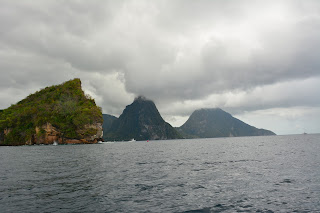Our ship - Royal Caribbean's Grandeur of the Seas - departed from Baltimore (Maryland) and spent three days at sea before arriving at Charlotte Amalie, St. Thomas.
St. Thomas was ruled by the Dutch, Danes, and British at various times during its modern history. Since 1917 when it was purchased for $25M in gold (along with neighboring St. John's and St. Croix), it has been part of the US Virgin Islands. It has the horrible distinction of having had the largest slave auctions in the world for some years in the late 17th century. It also has the oldest synagogue in continuous use anywhere in the United States or its external territories.
Pirate connection: While we were excited to take a swim in the crystal blue waters of Sapphire Beach, you can visit Blackbeard's Castle a National Historic Landmark built by the Dutch in 1679 to protect the harbor, the Pirates' Treasure Museum, and Drake's Seat lookout with a panoramic view named after the famous sailor.
Sapphire Beach - amazing view and great snorkeling
Just watch out for the locals. They can be a little prickly!
Our next stop was Antigua, which is part of the Lesser Antilles in the West Indies. It gained its independence from the British Empire in 1981 and has since become a hub of many financial institutions.
Pirate connection: As part of our 2.5 hour tour, we saw beaches, rainforests, as well as Nelson's Dockyard, which was built by the British in the 1740s and named after Horatio Nelson. Now a UNESCO World Heritage Site, it was used by the Royal Navy as the base of its Caribbean operations until 1889. It is now the oldest working Georgian shipyard in the world.
Nelson's Dockyard
One of Antigua's many beaches.
St. John's, Antigua
In spite of still nursing a sunburn, I think St. Lucia was my favorite out of all our stops. We signed up for a 5 hour tour that took us by a speedboat from the harbor in Castries to the southern part of the island, Soufrier. After taking a mud bath in a dormant volcano, we washed off in a waterfall, then finished with a stop at the beach at Marigot Bay.
Pirate connection: Local guides may tell you that parts of the first Pirates of the Caribbean: Curse of the Black Pearl were filmed on St. Lucia. It's true you can find a similar seaside arch/cave where Jack Sparrow sees the skeletons of the hung pirates, but Google tells me the real one is on St. Vincent and the Grenadines.
St. Lucia's Arch ('lady slipper') - locals will cliff dive for you for tips
The "Pirate Rock" in St. Vincent (not on our trip).
The PotC scene, for comparison.
The Pitons - two mountainous, volcanic plugs that are also a World Heritage Site.
Is that the Black Pearl? No, just a local booze cruise!
Marigot Bay, which did not stand-in for Port Royal in PotC. That was Wallilabou Bay in St. Vincent.
St. Kitts was claimed for Spain by Columbus in 1493. It was later also settled by the French and British. It is separated by a two-mile channel from its sister island, Nevis. Part of the Leeward Islands, they have been an independent country since 1983. This island also has three distinct volcanic peaks, the last of which erupted in 1620.
Pirate connection: We took another guided tour, this time from the harbor in Bassitere to the Wingfield Estate, the site of a 17th century rum distillery. In addition to the historical ruins, the adjacent rainforest is not to be missed! Brimstone Hill Fortress National Park helped the British defend their claim to the island for many years. It is a UNESCO World Heritage site and the largest fortress built in the Eastern Caribbean (and also one of the best preserved in the Americas).
They made rum here.
Local flora.
Local fauna.
Middle Island Anglican Church - oldest Anglican church in Eastern Caribbean, built in 1623. Per our guide, an ancestor of US President Thomas Jefferson (Samuel Jefferson II, his great great grandfather) is buried here.
Brimstone Hill Fortress - designed by the Brits, built by slaves, occupied briefly by the French and then retaken by the British, it was abandoned from military use in 1853.
Claiming the garrison for pirates everywhere!
Fire!
Pirate connection: Everything it seems leads back to rum! Check out the label of local St. Maarten brew 10 Saints' Beer. It was aged in rum casks!
Beer aged in rum casks.
View to my right: Maho Beach's famous fly-by landings with the airport runway starting at the fence line on the far right.
View to my left: Maho Beach's tide pools.
After five days on five different islands, it was time to head back north again. This was an amazing trip and it has definitely solidified my love of pirates and inspired me to continue writing them. With that said, it's almost the end of this post . . .
. . . but before that, here's a little teaser for what I have coming up next! It's in the form of a picture puzzle, which will be revealed bit-by-bit on this blog. Any guesses of what's behind the 9 tiles?


























No comments:
Post a Comment